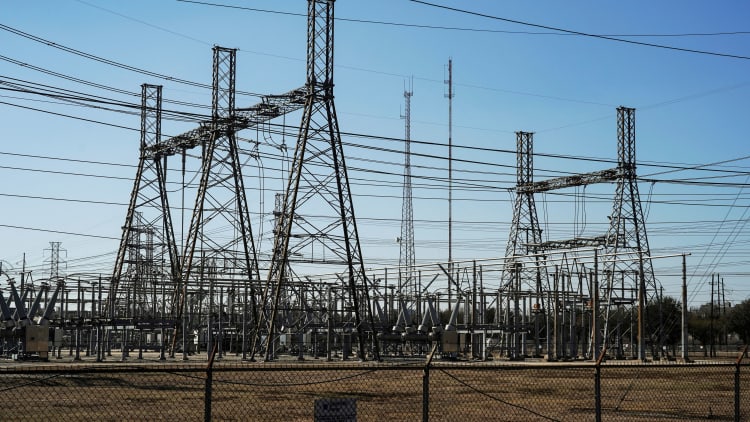California, Midwest, at high risk of electricity shortages: NERC
Wind turbines and power transmission lines at a wind farm near Highway 12 in Rio Vista, California, on Tuesday, March 30, 2021.
David Paul Morris | Bloomberg | Getty Images
America’s electrical grid is being pushed to the breaking point, and California, parts of the Midwest and parts of the South Central United States are at “high risk” for energy shortfalls, says the not-for-profit organization charged with managing and evaluating the grid.
“High risk” regions, marked in red on the map, may see shortfalls at “normal peak conditions,” according to the 54th annual assessment from the North American Electric Reliability Corporation released Thursday.
The reasons for the shortfalls vary.
In the Midwestern states and Ontario, more power generation is being retired than is being added back online, NERC’s Mark Olson told reporters Thursday. Projected energy shortfalls have been projected in that region since 2018, Olson said.
In California, the risk is due to a “variable resource mix” and “demand variability,” Olson said. That means there’s a lot of renewable energy in the state, and its generation is not coordinated with the times people need the most energy. NERC predicts that demand could fall below supply for 10 hours during peak summer months in 2024.
Much of the rest of the Midwest and the rest of the Western part of the United States are at “elevated risk” (yellow on the map), which means shortfalls may occur in extreme conditions, like during severe weather or hot spells where everyone is running air conditioners. In New England, the elevated risk comes in the winter when people use generators that depend on natural gas.
“The natural gas capacity can be insufficient for generators, leading to use of backup fuels, stored liquid fuels, and there are risks to being able to maintain sufficient fuel storage during long duration events,” Olson said.
The Southwest could also suffer when demand is high and wind energy generation is low in the region.

‘Extraordinary times’
“We are living in extraordinary times from an electric industry perspective,” John Moura, the director of reliability assessment at NERC, said on Thursday.
Increasing awareness of climate change is pushing utilities to phase out fossil fuel-based sources of energy that generate carbon emissions. Renewables like wind and solar don’t contribute to climate change, but have period where they don’t generate any energy (when the sky is dark or the wind is still).
Renewables also don’t necessarily map to where demand is, unlike fossil fuels, which can be transported and burned near where they’re consumed. That means more transmission lines are needed, and building them can take from seven to 15 years, Moura says.
Another area of note, according to NERC, is the increased power demand of cryptocurrency mining and the need to plan for energy usage there.
Then there’s the weather. It’s tricky to tie particular extreme weather events to climate change, but it’s generally…
Read More: California, Midwest, at high risk of electricity shortages: NERC
